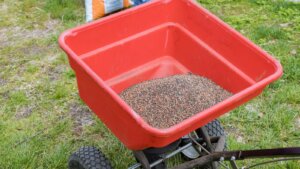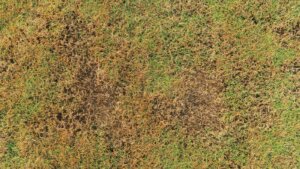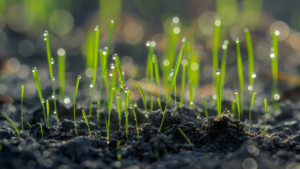Artificial turf has become a wildly popular alternative to traditional lawn care solutions due to its low maintenance and durability. But with so many artificial turf infill options available on the market, how can you decide which one is right for your lawn? In this article, we’ll explain what artificial turf infill is, why it matters, and how you can select the right infill for your artificial turf.
What is Artificial Turf Infill?
By definition, artificial turf infill refers to any ‘artificial’ product that is used to fill in the space between the plastic blades of synthetic grass. There are a wide variety of options when it comes to infill for artificial turf (which we will cover in greater detail in the next section), but how can you know if infill is necessary for your lawn?
For starters, infill can help keep artificial turf fibers taut and upright, giving the surface a fuller, more luscious look. Without the presence of infill, artificial turf becomes more prone to breakage, fraying, as well as getting matted down. By adding artificial turf infill to your lawn, you can actually extend the life expectancy of a turf surface and keep your outdoor spaces looking prim and proper for much longer than normal.
What are the Different Artificial Turf Infill Options?
Although this list may not be exhaustive, it should provide homeowners with a good idea of some of the most common artificial turf infill options available and a brief overview of their respective advantages and disadvantages.
Acrylic Sand
Made from coated sand particles designed to resemble natural grass, acrylic sand is a popular choice as an artificial turf infill solution. Acrylic sand can provide a cushioning effect to help the turf fibers remain upright, and it’s particularly good at retaining moisture and having a natural appearance. One disadvantage to acrylic sand is that it can be more costly than other infill options, and it can settle and compact over time, reducing its overall effectiveness.
Silica Sand
This material is commonly used in artificial turfing applications and is made primarily from quartz. Silica sand is generally known for its absorbing qualities as well as its durability. While it’s resistant to bacteria growth, silica sand may slowly compact over time which can inhibit its cushioning properties and may trap excess heat from the sun, making the turf less comfortable to walk or play on during summer months.
Cork
Made from the bark of cork oak trees, cork is a natural infill material that provides a nice cushioning effect. In addition to helping keep turf fibers upright, cork also offers natural resilience, improved moisture absorption, and it’s more of an eco-friendly option as opposed to other, synthetic infill options. However, in some cases, cork may need to be replenished more frequently due to its biodegradability. Cork is also generally more expensive than other infill solutions.
Hydrochill
Sometimes also referred to as “Chill fill,” Hydrochill is made from sand and other materials and is able to stay much cooler in direct sunlight compared to other infill materials. Thanks to evaporative cooling, Hydrochill slows heat absorption when in direct sunlight and sheds heat much more quickly than other infills. While it regulates turf temperature much better, it provides less shock absorption and can compact like other sand-based infill products.
Rubber
There are a couple of different types of rubber that can be used in artificial turf infill applications, but the two primary options are crumb rubber and EPDM rubber. Crumb rubber is a black substance made from recycled materials and is one of the most popular and affordable options for infill. Some drawbacks to crumb rubber are the fact that it gets really hot in direct sunlight, and there are potential health concerns since the materials used to make crumb rubber often come from recycling plants or other waste management facilities.
Conversely, EPDM (Ethylene Propylene Diene Monomer) rubber comes in a variety of colors, is highly durable, and can be a great low-maintenance solution. Like crumb rubber, EPDM rubber is highly durable and is a great solution for athletic fields and backyards alike with greater shock absorption capabilities. EPDM can also get quite warm on sunny days, although it depends on the color.
Coconut or Walnut Shells
As organic turf infill options, coconut shells and walnut shells provide as many of the advantages as synthetic options with the added benefit of being more environmentally friendly. These materials are able to absorb moisture and are naturally resistant to bacteria, and they also stay cooler than other infill options in direct sunlight. Because they are made from organic materials, however, they will break down over time and it may be more costly to replenish than other infill materials.
Zeofill
Zeofill (also known as Zeolite or Zeolite Max) is made from highly porous volcanic rocks and ash and is specifically designed to absorb more moisture and neutralize unpleasant odors – making it an ideal option for pet owners. Zeofill is also naturally resistant to bacteria and mold growth, and because it’s so porous, it stays much cooler in direct sunlight than other turf infill materials. Because it’s so lightweight, however, it may not be best to use Zeofill on its own. Zeofill can also compact like sand, and is generally more costly than other infill options.
Ready to Revitalize Your Artificial Lawn?
If you have been considering artificial turf for your lawn, or you want to find an infill option that revitalizes your artificial turf, there are a number of different infill options available. It basically boils down to what kind of look and feel you want for your artificial surface. Do you want an affordable, low-maintenance solution, or would you rather have an infill that helps regulate turf temperature, or provides shock-absorption qualities?
Each material has its advantages and disadvantages, so it’s important to weigh your options carefully before making a decision. You can also consult a professional lawn care service or a professional infill installer to get a better sense of which infill option would be best to suit your specific needs. By taking the time and carefully considering your options, you can find an appropriate infill material that is safe, comfortable, and aesthetically pleasing.



